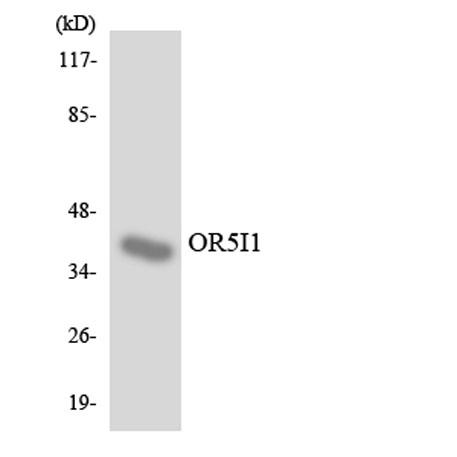| Product name: |
Olfactory receptor 5I1 rabbit pAb |
| Reactivity: |
Human;Rat;Mouse; |
| Alternative Names: |
OR5I1; OLF1; Olfactory receptor 5I1; Olfactory receptor OR11-159; Olfactory receptor-like protein OLF1 |
| Source: |
Rabbit |
| Dilutions: |
Western Blot: 1/500 - 1/2000. Immunofluorescence: 1/200 - 1/1000. ELISA: 1/10000. Not yet tested in other applications. |
| Immunogen: |
The antiserum was produced against synthesized peptide derived from human OR5I1. AA range:206-255 |
| Storage: |
-20°C/1 year |
| Clonality: |
Polyclonal |
| Isotype: |
IgG |
| Concentration: |
1 mg/ml |
| Observed Band: |
38kD |
| GeneID: |
10798 |
| Human Swiss-Prot No: |
Q13606 |
| Cellular localization: |
Cell membrane; Multi-pass membrane protein. |
| Background: |
olfactory receptor family 5 subfamily I member 1(OR5I1) Homo sapiens Olfactory receptors interact with odorant molecules in the nose, to initiate a neuronal response that triggers the perception of a smell. The olfactory receptor proteins are members of a large family of G-protein-coupled receptors (GPCR) arising from single coding-exon genes. Olfactory receptors share a 7-transmembrane domain structure with many neurotransmitter and hormone receptors and are responsible for the recognition and G protein-mediated transduction of odorant signals. The olfactory receptor gene family is the largest in the genome. The nomenclature assigned to the olfactory receptor genes and proteins for this organism is independent of other organisms. [provided by RefSeq, Jul 2008], |










 Western Blot analysis of 293T cells using Olfactory receptor 5I1 Polyclonal Antibody diluted at 1:1000
Western Blot analysis of 293T cells using Olfactory receptor 5I1 Polyclonal Antibody diluted at 1:1000 Immunofluorescence analysis of A549 cells, using OR5I1 Antibody. The picture on the right is blocked with the synthesized peptide.
Immunofluorescence analysis of A549 cells, using OR5I1 Antibody. The picture on the right is blocked with the synthesized peptide. Western blot analysis of lysates from HepG2 cells, using OR5I1 Antibody. The lane on the right is blocked with the synthesized peptide.
Western blot analysis of lysates from HepG2 cells, using OR5I1 Antibody. The lane on the right is blocked with the synthesized peptide. Western blot analysis of the lysates from RAW264.7cells using OR5I1 antibody.
Western blot analysis of the lysates from RAW264.7cells using OR5I1 antibody.
 Manual
Manual